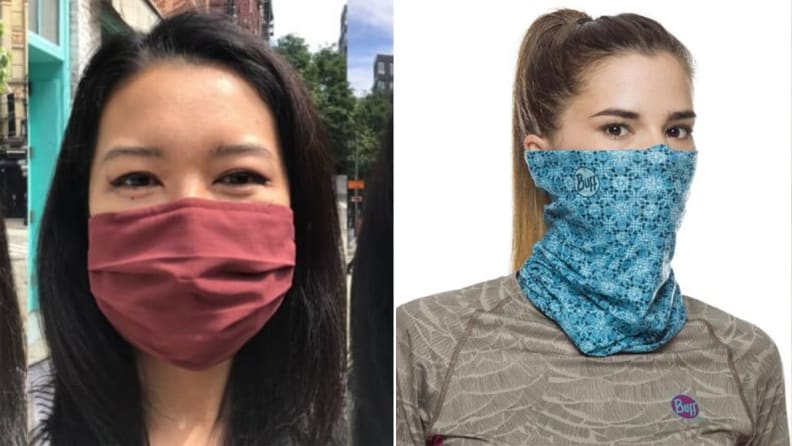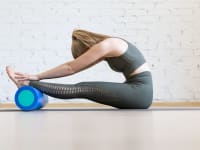Want to exercise outdoors? Here's what you need to do to stay safe
Get your endorphin and sunshine fix—while taking pandemic precautions.
Products are chosen independently by our editors. Purchases made through our links may earn us a commission.
Exercising inside your home is a great way to keep up with your fitness during the coronavirus pandemic. But no matter how many workout apps you’ve downloaded and how many fancy new pairs of running shorts you’ve indulged in to motivate yourself to exercise, it’s possible that you’ve grown weary of your at-home routine.
But even if your regular gym or fitness studio is still closed (or you just aren’t comfortable going to the gym right now), you have another option: the great outdoors. If you keep your distance from others, and wear a face covering when close proximity to others is unavoidable, it’s possible to get your endorphin and sunshine fix and stay safe. Here’s how to do it.
Think of exercise as an extra level of prevention
Getting some movement, whether you take a bike ride, put on some roller skates, go for a hike, do yoga in your living room, or take some brisk walks here and there, can help you stay healthy.
“All exercise is beneficial for stimulating the immune system to do its job better,” says Dr. David Nieman, professor of biology at Appalachian State University and director of the university’s Human Performance Laboratory. “Exercising regularly helps prevent the likelihood of getting sick from a variety of causes.”
And being outside—whether you’re exercising or not—can also be beneficial. Getting a change of scenery, some fresh air, and sunshine can help you “mentally as well as physically,” according to Nieman. “In my view, going outside in a safe environment with a spouse or family member or whoever you’re quarantining with is one of the best things to do right now,” he says.
Keep away from crowds as much as possible
The risk of contracting coronavirus likely diminishes when you’re outside. Fresh air and wind currents dilute the virus, making infection less likely, according to Harvard University.
Still, when you venture out, it's prudent to stay six feet away from other people at all times—especially if they’re also working out. This means you should avoid suggesting you meet a friend for a jog, walk, or other forms of outdoor exercise where you may not think to stay six feet apart, unless you’ve been quarantining with your exercise partners.
During high-intensity exercise, people sweat, spit, and breathe heavily, potentially expelling large quantities of germs. “It’s a spittle factory and it is just not safe at all in a big group,” says Nieman. “If you’re in the slipstream behind somebody who has a virus and they’re doing the typical spitting, you’re probably going to [be exposed].”
Bring a mask wherever you go
Depending on where you live, a mask may be required every time you go outdoors. Even if it’s not a mandate, it’s good protocol to have a mask with you whenever you leave your house and even when you're working out, so you can slip it over your nose and mouth (yes, both!) when you pass someone on a trail or if you decide you want to stop by a coffee shop on your way home. If you end up in a crowded area, play it safe and keep the mask on—and, if the mask starts to impede your breathing, slow down until you’re in a roomier zone and can safely remove it.
“When you feel good about it, just put the mask on, especially if the exercise is moderate like a walk,” says Nieman. “The benefits outweigh the risks [so much] that it’s highly recommended.”
Choose your mask carefully

The mask you wear outside should be light and breathable.
No matter what, it’s difficult to engage in high-intensity activity in a mask. But some masks make it easier than others. Our top-rated mask is from fitness brand Athleta—it’s thinner than most other masks, so it feels less restrictive to the face, but is triple-layered so it’s still protective. Other athletic brands, like Boco Gear, Eliel, and Backcountry make face masks that could be more conducive to exercise.
Another good option is to wear a gaiter, a multi-purpose tube-shaped garment that slips over the head and can be used as a face mask, neckerchief, headband, and more. Whatever you’re doing, it’s easy to slip around your neck before you head out and pull over your nose and mouth whenever you pass someone (and keep it there, if need be). Ones from Buff are made of a cooling, sweat-wicking polyester and elastane blend and have a UPF rating of 50 to offer sun protection as well.
Some people claim a simple bandana is easiest to exercise with, because it doesn’t clamp around the mouth and thus makes it easier to breathe. If you like the bandana style but prefer one made of a lightweight, sporty fabric, the one from sports bra brand Koala Clip may be a good option.
Consider taking an outdoor fitness class
Missing the yoga or HIIT classes you used to take pre-pandemic? Check in with the studios in your area—they may be offering outdoor classes. If so, Nieman says you can feel reasonably safe going, as long as the instructor enforces social distancing and you bring your own yoga mat or other workout equipment (which may be required anyway). “I think that the risk of infection [in an outdoor workout class] is very low,” he says. “If they have a decent structure, it should be just fine without a mask.”
Of course, use your own judgment here: If you are in an at-risk demographic or are immunocompromised, live with someone who ticks those boxes, or just feel nervous about being in a class setting, there’s no need to push yourself into it. Before you sign up, do some research to see how the class will be handled, such as if they’re enforcing six-foot distances between participants, if they’re stopping hands-on adjustments, and if the instructors are wearing masks.
Wash up when you get home
No matter your outdoor workout of choice, Nieman recommends hopping in the shower as soon as you get home (which was probably your plan anyway, after a summertime outdoor workout). “Focus on your eyes, your nose, your whole face area, and your hands,” he says. “Just make sure you use a lot of soap and get off anything that you may have picked up.” Bathing helps prevent the risk of fomite transmission, a route of transmission in which disease is spread through inanimate objects—say, your hands touch something that has germs on it, then you touch your eyes or mouth.
If you can’t get in the shower right away, make sure to wash your hands—with soap and water for a full 20 seconds—before you do anything else, even get into your car, if you can (or use hand sanitizer, in a pinch).
Don’t forget the basics of summer workout safety
Of course, there are other, non-pandemic measures to take when exercising outside in hot weather. Make sure you drink plenty of water before you head out and bring a water bottle with you—especially as you should avoid public water fountains (assuming they are even turned on). You’ll also want to apply some SPF. Choose a formula that’s water-resistant, so you don’t sweat it off as soon as you get outside, and add on a visor and some sunglasses.
Another thing to look out for: cars. Traffic dipped significantly in many cities at the start of the pandemic, but this doesn’t mean that there are no cars on the road anymore. If you’re entering the street for any reason, whether it’s to cross it or give people on the sidewalk more room as you pass, remember to look both ways before you venture into it.
Basically? Like a lot of things these days, working out is more complicated than it used to be—but if you take the right precautions, it doesn't need to feel that way.
The product experts at Reviewed have all your shopping needs covered. Follow Reviewed on Facebook, Twitter, and Instagram for the latest deals, product reviews, and more.


